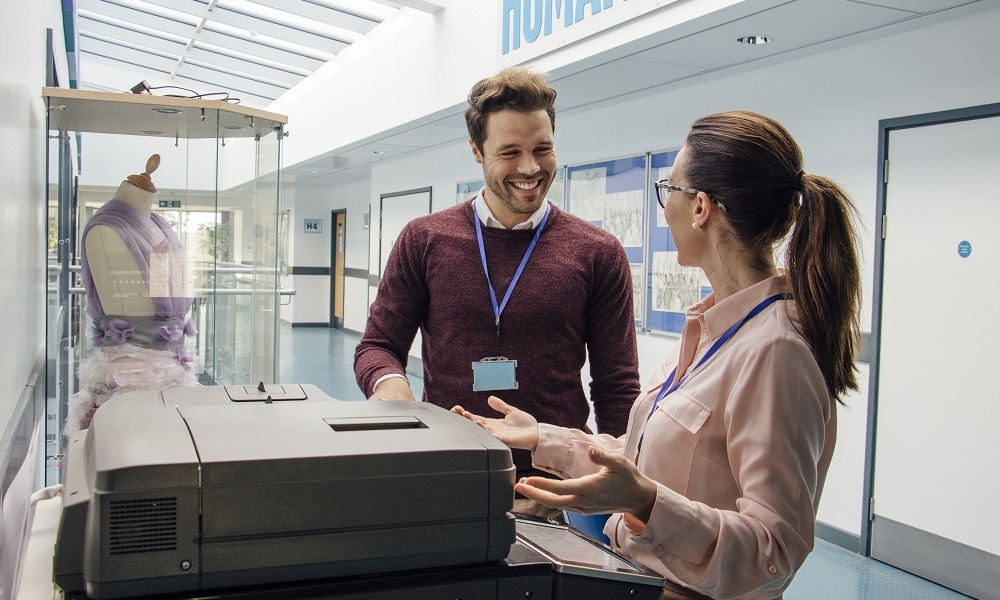This podcast from Teacher magazine is supported by Bank First. Bank First is proud to support the financial wellbeing and professional development of the education community. Visit bankfirst.com.au to find out how they can help you reach your financial goals.
Hello, and thank you for downloading this podcast from Teacher magazine. I'm Dominique Russell. We're taking you to the Northern Territory in this episode of Teaching Methods, where a primary school was purposefully built to house classrooms of students taught by co-teachers. The school, Rosebery Primary, is in its ninth year this year, and Principal Gail Smith joins me on the line today to discuss how co-teaching has improved outcomes for students, how trusting co-teacher relationships are maintained and some possible hurdles to adopting the process. We begin this episode with Gail providing some context of her school.
Gail Smith: Rosebery Primary School is a school that's in its ninth year. So, we're not a very old school. And, our school was actually designed in a way that ensures co-teaching takes place. So, our architectural design is actually for co-teaching. We have a rather large school in terms of schools in the Northern Territory, so we have upward to 600 students from preschool right across to Year 6.
Our school context is what you would call, probably, a normal urban school in the Northern Territory. We have quite a range of students with different backgrounds. We have a large contingent of Indian families at our school, for example. We don't have too many Indigenous students, but we do have a percentage. We have also a lot of workers who come to the Territory for work, stay for a short period of time, and then move on – so a fairly transient population. That also includes our teachers.
Dominique Russell: So, why was it so important for the school to adopt a team teaching approach right from the outset?
GS: So, it's a little bit different to team teaching, actually. Co-teaching is what we call it. And co-teaching is when you're co-dependent on each other, pretty much. And the school was designed that way. It was in the educational brief. So, our classrooms are open classrooms – double-sized rooms where two classes and two teachers spend their day learning together. So, we had to work out a way that was going to allow teachers the opportunity to really engage with each other in a way that was going to be positive for them and positive for the students and their learning.
So, co-teaching was always on the burner for this school when it was first built, and we've just had to continue with that model because of the design of the school.
I think, you know, the power of two is a presentation that was done by some of our staff at a conference once, and we called it The Power of Two: Co-teaching at Rosebery Primary School. And, to me, the power of two is really important when you are looking at making a learning environment interesting, engaging and collaborative. You've got to do it with more than one teacher, otherwise it's not really collaborative in terms of adult collaboration. The kids see that and the kids actually step up as well.
But, you do have to have the structures in place. I think co-teaching is fantastic. Team teaching is one part of co-teaching, but a lot of people get them confused. Co-teaching, for me, is definitely the way to go.
This might not be entirely how everyone sees it, but for me, co-teaching is that you co-collaborate, you co-work through everything so it's done together. And you know what each other is going to be doing, and you know where you're at with your lessons, you know what you need to be doing next. If you are a team teacher, you still have your class, you still have your own planning, you just do some things together. It's quite different in the sense that co-teaching is you're responsible for all of these students, and this is how we work as two, as a pair.
DR: I'm interested in perhaps how students, and parents as well, respond to this method of co-teaching? How is it that you explain the benefits to them and what is their response like?
GS: I think right from the very beginning when I enrol students at our school, I always make a point of letting them know that we are a different school; we are a school that co-teaches. And we work with our students and our teachers to ensure that that's a successful learning environment and working relationship. So, we have some underlying core values and beliefs around co-teaching, and we believe and know that it does develop academic improvement and their social skills.
It also has increased opportunities for the teachers because purposeful student engagement leads to better outcomes. And we know that by two people working together, bouncing ideas within the classroom or supporting each other to give good learning opportunities, those learning conditions improve. It also creates professional growth for teachers. If one teacher has a strength in a particular area and the other doesn't, then you can say, ‘Well, I'll take that area to teach, to have the explicit teaching around, and you can be the supportive teacher in that role'. It also fosters a greater sense of the community in the classroom.
So that's on the teacher side, the co-teaching side, but we also do a cooperative, collaborative learning approach with our students. So we actually teach them, also, how to actually work together, how to support each other and how to make sure that everyone feels like they're part of the learning. Not just as an individual … also as an individual, but it's done in a collaborative way.
DR: Obviously ensuring that the co-teachers have a really trusting and respectful relationship developed is incredible important. So, how is building those strong relationships approached and also maintained at your school?
GS: Yeah, and that's a tricky one at times. Because if you're getting new people coming into the school, you don't really know them. So, matching teachers up to be with the best person they can be with to co-teach is really important. So, we use a number of different methods. I mean, our philosophy and belief is that co-teaching is a better environment of student learning – that's the premise that we come from.
But what we do is we use the team management index which teachers actually complete. It tells us how they like to work in teams, and that way we can maybe put them with the best person that they should be with. Personalities have a lot to do with it. Some people actually come to our school because they want to co-teach. They see it as a supportive type of classroom to be in. They also see it as one where they can learn from another person right there in front of them.
We also make sure that there are purposeful partnerships between the two co-teachers. It's a bit like a marriage – if you don't communicate the wheels will fall off. That's the thing that I tell people, that if you don't communicate, the wheels could fall off. So, it's a very high-communicative process that the teachers need to go through.
The collaboration that they do on a daily basis in the classroom is the superficial planning stuff, but the deeper planning happens because we give them two hours of non-contact time off together where they can actually plan. So, they know every minute of the day, what they should be doing. And what one teacher is doing at one end of the classroom, and if the other one is at the other end with another group, it would be the same thing. So we don't want Science being taught at one end and Maths being taught at the other end at the same time. We want them to be really explicitly teaching the same thing at the same time and then maybe coming together as a whole class, as one big class with two teachers.
DR: Fantastic, for perhaps other teachers and school leaders that are listening, what are some possible hurdles to be aware of?
GS: Yeah, and there are hurdles. Not everyone can teach in an environment where you have upward of 50 students in one room. And, you know, we try to keep our numbers at 25 in each class maximum, but that can't always happen. So, you've got about 50 students in front of you on a daily basis, two teachers. But it's about the way that you work together, which the students can then see and understand that collaborating and cooperating together is so important.
When things go wrong – I guess, if you're not communicating properly things can quickly go pear-shaped. But, also if someone's not really understanding the whole co-teaching process, then that can make things difficult as well. So, we use a basic resource that we work with our teachers on and it's a document that gives them a guide to co-teaching. It's not what we use entirely, but it's a good guide for them to understand what co-teaching is about.
We get them to use a co-teaching framework to work with their partner on so they've got some understanding about the context of their class together. They create a philosophy together; they create a name for their class (there's one); they understand that the behaviour management strategy within the school is the same for everybody; the way that they instruct and use their environment needs to be very, very clear and planned out. If that doesn't happen, then things don't work quite right. You can't have a noisy thing happening on one end of the room when you've got a quiet thing happening at the other.
So, all of those things are so important. Communication is the key, and relationships.
DR: Yeah, definitely. And just finally, you've said on the school website: ‘We firmly believe that the effort required by co-teaching is worth it, because it results in happier and more successful children, as well as more confident and competent staff'. Could you elaborate on that a bit more?
GS: Yeah, I think the important thing about that is that we have seen how successful it can be when it works and that's what we want to replicate over and over again. We want to replicate what works best. And really showing that we fully support it as a school by allowing them those two hours of planning time every week without fail together really helps. Having a co-teaching framework really helps.
Then, they also have a co-teaching reflection tool. So these things build purposeful partnerships with them. They get to observe other people in their classrooms; they can go with their co-teaching partner and go and observe other co-teaching partners if they want to. So, we see that as being professional learning for them. So it gives teachers what they need. If they need to go and see something, they can do that together or they can do it separately. So that gives them the confidence to come back and know that it's not just their classroom that's experiencing something that they might be having difficulty with. They can find that out by observing another co-teaching pair.
So, for us, we know that the success for the kids is about that collaboration as well, so it's a collaborative approach we have for the kids, and for the teachers. It's just across our whole school. And when you've got that working right, the school hums.
When you've got a co-teaching pair that it's not working so well with, well then that's when you go in with the support and the mentoring and the coaching to help them improve the standard of their co-teaching partnership. But, yeah, it does certainly give confidence to staff who might need a little bit of support. But it's also, kids love it.
I had a child once draw a picture – we asked them, ‘What's co-teaching mean to you?' – and they drew a body of a teacher with two heads. And they said, ‘This is our classroom. We have two teachers, but really they're one.' That was just lovely.
That's all for this episode. To access the full transcript of this podcast, head to teachermagazine.com.au – that's where you'll also find the latest articles, videos and infographics for free. And, our entire podcast archive is available at acer.ac/teacheritunes or soundcloud.com/teacher-acer.
You've been listening to a Teacher podcast supported by Bank First. Bank First has been committed to the education community since 1972 and is proud to be invested in you. Visit bankfirst.com.au to find out more.
Gail Smith says: ‘The power of two is really important when you are looking at making a learning environment interesting, engaging and collaborative. You’ve got to do it with more than one teacher, otherwise it’s not really collaborative in terms of adult collaboration.’
Thinking about your own school context, how do you demonstrate adult collaboration to students?
Gail Smith says communication and relationships are the key to successful co-teaching relationships. As a school leader, how do you support staff in forming meaningful relationships with each other?


